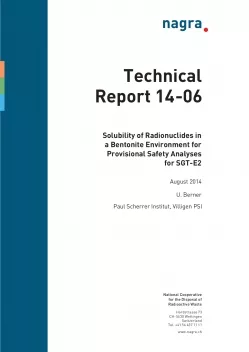
Technical Report NTB 14-06
Solubility of Radionuclides in a Bentonite Environment for Provisional Safety Analyses for SGT-E2
Within stage 2 of the sectoral plan for deep geological repositories for radioactive waste in Switzerland provisional safety analyses are carried out. In the case of the repository for spent fuel and vitrified high level waste considered retention mechanisms include the concentration limits of safety relevant elements in the pore water of the buffer material (bentonite).
The present work describes the solubility limits of the safety relevant elements Be, Cinorg, Cl, K, Ca, Co, Ni, Se, Sr, Zr, Nb, Mo, Tc, Pd, Ag, Sn, I, Cs, Sm, Eu, Ho, Pb, Po, Ra, Ac, Th, Pa, U, Np, Pu, Am and Cm in the pore water of bentonite after diffusive solution exchange with the host rock Opalinus Clay.
The term solubility limit denotes the maximum amount of an element dissolving in the pore solution of the considered chemical reference system. Chemical equilibrium thermodynamics is the classical tool used for quantifying such considerations. For a given solid phase equilibrium thermodynamics predict the amount of substance dissolving in the solution and describe the speciation of the considered element in solution. The principles of chemical equilibrium will also be the primary work hypothesis in the present work.
Solubility calculations were performed with the most recent version of GEMS/PSI (GEMS3.2 v.890) using the PSI/Nagra Chemical Thermodynamic Data Base 12/07, which is an update of the former Nagra/PSI Chemical Thermodynamic Data Base 01/01. The database was complemented with datasets from the ThermoChimie v. 7b for elements that were not considered in the mentioned update (Ag, Co, Sm, Ho, Pa, Be), with data from IUPAC (Pb) and with data from the literature (Mo). Differing sources for thermodynamic data are noted.
Reference values as well as lower and upper guideline values are evaluated. For many formation constants of solids and solutes uncertainties are known and allow conveying lower and upper guideline values. In many cases it is not clear whether the most stable solid is formed. In such cases the (kinetically driven) formation of alternative solid phases is included in the derivation of reference and guideline values. This procedure is based on expert judgment. Corresponding justifications are given for the individual elements and are an integral part of this work.
A similar report for an almost identical chemical environment has been produced in 2002, based on the PSI/Nagra Thermodynamic Data Base 01/01. A comparison of the solubility limits illustrates that for most of the elements the difference to this former work is below one order of magnitude.
